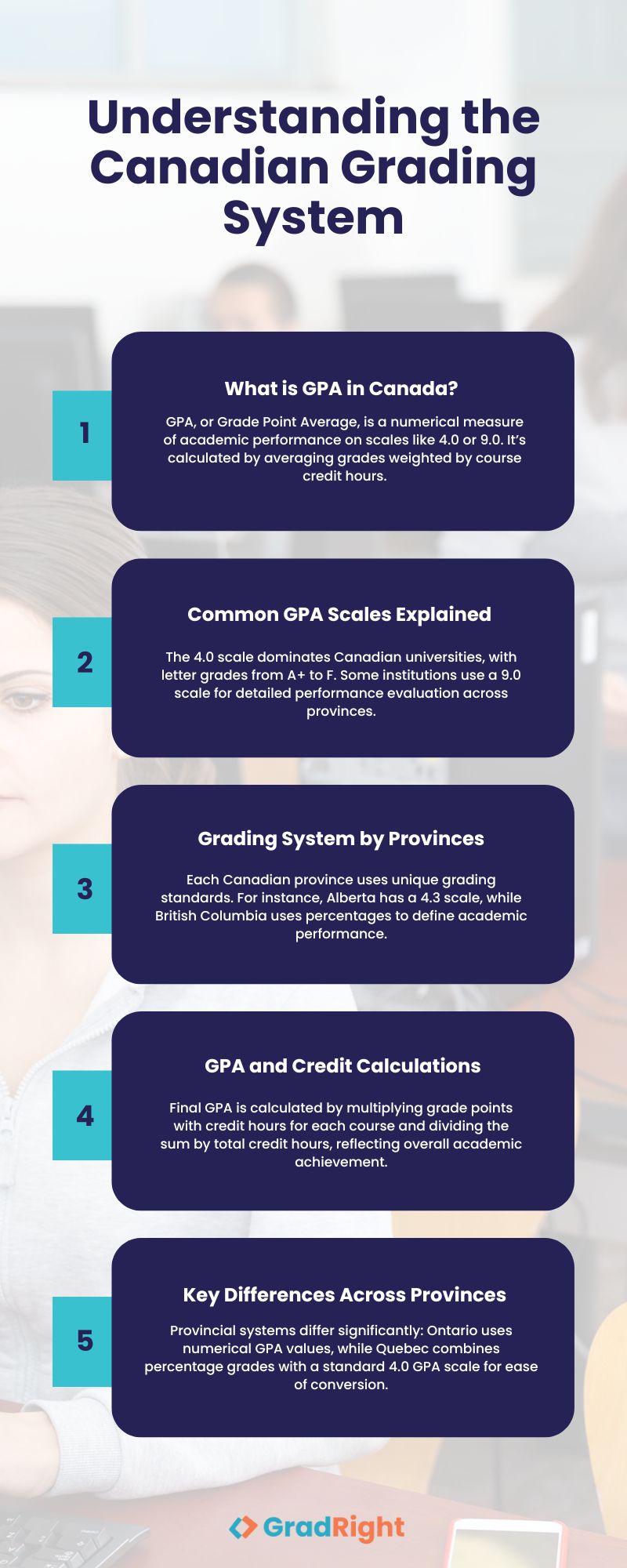Grading System in Canada: Everything You Need to Know About Canada’s GPA System
Canadian universities are a favorite destination for Indian students who want to study abroad. The country has a world-class education system and offers plenty of post-degree work visas, making it quite attractive for those who wish to settle abroad after their education.
Before you travel to Canada, it is important to know about the intricate Canadian grading system. The grading system in Canadian colleges and universities varies depending on the province, institution, or type of education.
In this article we explore the essentials of Canada’s GPA system, how it works across different provinces, and what constitutes a “good” GPA in Canada.

What is GPA?
GPA stands for ‘grade point average’, a numerical value that indicates how well a student performs academically. It’s calculated by converting a student’s grades into a percentage and then averaging them. GPAs are usually reported on a scale of 0 to 4, with 4 being the highest grade and 0 being the lowest.
The grading system used in Canada is quite complex. There is no single scale to which every university adheres. Therefore before you move to Canada and begin higher education it is best that you completely acquaint yourself with the Canadian grading system.
Here is a concise overview of the Canadian grading system:
Calculation
GPA is calculated by averaging the grade points earned in all courses, with each course weighted by its credit value.
Scale
GPA is usually calculated on a scale of 4.0 or 9.0.
Credit hours
Each course has a specific number of credit hours assigned to it. The number of credit hours per course is predetermined by the faculty and is mentioned in the course schedule.
GPA and letter grades
Here are some examples of letter grades and their corresponding GPA values:
A: 3.9 grade-point value, 85-89%
A-:3.7 grade-point value, 80-84%
B+: 3.3 grade-point value, 77-79%
B: 3.0 grade-point value, 73-76%
In the following sections, we expand on these details.
GPA calculator in Canada
Canada’s grading system is used across all levels of education, from elementary school to university. It generally uses letter grades with corresponding percentage scores, but there are some variations.
Here is a table depicting the Canadian grading system with various letter grades, their corresponding descriptions, and percentages.
| Grade | Description | Percentage Range |
| A | Excellent | 90–100% |
| B | At government standards | 80–89% |
| C | Approaching government standards | 70–79% |
| D | Well below government standards | 60–69% |
| F | Fail | Below 60% |
Common Canadian GPA scales
While there’s no one-size-fits-all scale, here are two of the most common ones:
4.0 Scale
This scale is used by most universities for admissions and internal assessments.
| Grade Points | Letter Grade | Description |
| 4.0 | A+ | Excellent |
| 3.7 | A | Very Good |
| 3.3 | B+ | Good |
| 3.0 | B | Good |
| 2.7 | B- | Satisfactory |
| 2.3 | C+ | Satisfactory |
| 2.0 | C | Satisfactory |
| 1.7 | C- | Marginal |
| 1.3 | D+ | Poor |
| 1.0 | D | Poor |
| 0.0 | F | Fail |
9.0 Scale
Though not common, the 9.0 scale is also used by some Canadian educational institutions.
Here’s a table summarizing the grading system based on a 9.0 scale, including grade points, letter grades, and their corresponding descriptions:
| Grade Points | Letter Grade | Description |
| 9.0 | A+ | Excellent |
| 8.5 | A | Very Good |
| 8.0 | B+ | Good |
| 7.5 | B | Good |
| 7.0 | B- | Satisfactory |
| 6.5 | C+ | Satisfactory |
| 6.0 | C | Satisfactory |
| 5.5 | C- | Marginal |
| 5.0 | D+ | Poor |
| 4.0 | D | Poor |
| 0.0 | F | Fail |
Grading system in Canada as per GPA, credits, and credit hours
There are plenty of similarities between the grading system in Canada and the USA. There is a combination of letter grades, percentages, and GPA. The calculation of GPA depends on the grades earned in various courses and the number of credit hours assigned to each course.
Grade Point Average (GPA)
A Grade Point Average is a numerical representation of a student’s average grade across all their courses. It is calculated by assigning points to each letter grade and then averaging those points and demonstrating their overall academic performance on a standardized scale. Most Canadian universities employ a GPA scale ranging from 0.0 to 4.0 or 9.0, depending on the institution.
Credits
A bachelor’s degree typically requires 120 college credits, but the number of credits needed can vary depending on the program and institution. A master’s degree in Canada typically requires 30–60 credits. However, this number fluctuates, for example, a Master of Business Administration may require 72 credits.
Credit Hours
Credit hours quantifies the amount of learning time required for a course. They are used to assess the academic value of a course and to reflect the time commitment and difficulty associated with it. One credit hour is usually equivalent to one hour of class time per week. For example, a course that meets for one hour on Monday, Wednesday, and Friday is worth three credit hours.
This is how the final GPA is calculated in the Canadian grading system
Final GPA = ∑(Grade Points × Credit Hours) ÷ ∑Credit Hours
Canadian grading system for different provinces
The grading system in Canadian colleges and universities varies significantly across provinces since there are no centralized educational standards. As mentioned before, the Canadian grading system uses either a 4.0 or a 9.0 GPA scale. In addition, institutions assign letter grades (A+ to F) and respective grade points or percentages.
Here’s a summary of the key grading systems used in different provinces of Canada:
Alberta
Alberta employs a GPA scale of 4.3, widely used in its universities like the University of Alberta and the University of Calgary. Letter grades and percentages are closely tied.
| Letter Grade | Percentage Range | GPA Value |
| A+ | 90–100 | 4.3 |
| A | 85–89 | 4.0 |
| A- | 80–84 | 3.7 |
| B+ | 77–79 | 3.3 |
| B | 73–76 | 3.0 |
| C+ | 67–69 | 2.3 |
| C | 63–66 | 2.0 |
| D | 50–54 | 1.0 |
| F | Below 50 | 0.0 |
British Columbia
British Columbia uses a simpler system emphasizing percentages. This system is utilized by institutions like the University of British Columbia and Simon Fraser University.
| Letter Grade | Percentage Range | Notes |
| A | 86–100 | Outstanding |
| B | 73–85 | Good |
| C+ | 67–72 | Acceptable |
| C | 60–66 | Marginal |
| F | Below 50 | Fail |
Ontario
Ontario, home to major universities like the University of Toronto and McMaster University, uses a percentage-based system with letter grades converted to numerical scores.
| Letter Grade | Percentage Range | Numerical Score (GPA) |
| A+ | 95–100 | 9 |
| A | 87–94 | 8.5 |
| A- | 80–86 | 8 |
| B+ | 77–79 | 7 |
| C+ | 67–69 | 5 |
| D | 50–54 | 2 |
| F | Below 50 | 0 |
Passing grades in Ontario are generally above 50%, with a “P” or “Pass” grade available in some cases for courses not affecting GPA
Manitoba
In Manitoba, institutions like the University of Manitoba use a GPA scale up to 4.5, distinguishing it from other provinces.
| Letter Grade | GPA Value |
| A+ | 4.5 |
| A | 4.0 |
| B+ | 3.5 |
| C | 2.0 |
| D | 1.0 |
| F | 0.0 |
Nova Scotia
Nova Scotia applies a detailed letter grading system. Universities like Dalhousie and Saint Mary’s use this approach.
| Letter Grade | Percentage Range | Notes |
| A+ | 90–100 | Excellent |
| A | 85–89 | Very Good |
| B+ | 77–79 | Good |
| C | 60–64 | Satisfactory |
| F | Below 50 | Fail |
Quebec
Quebec follows a GPA system similar to other provinces, typically with a 4.0 scale.
| Letter Grade | GPA Value |
| A+ | 4.0 |
| A | 3.8 |
| B+ | 3.3 |
| B | 3.0 |
| C | 2.0 |
| D | 1.0 |
| F | 0.0 |
Notable institutions like McGill University also accept international grading conversions, often using specific equivalency guidelines
Saskatchewan
Saskatchewan uses a straightforward grading scale, often based on percentages.
| Letter Grade | Percentage Range | Notes |
| A | 80–100 | Excellent |
| B | 70–79 | Good |
| C | 60–69 | Average |
| F | Below 50 | Fail |
Prince Edward Island
The grading scale in Prince Edward Island closely resembles other provinces but includes a finer breakdown of grades.
| Letter Grade | Percentage Range |
| A+ | 91–100 |
| A | 85–90 |
| C+ | 67–69 |
| D | 50–56 |
| F | Below 50 |
General Observations about the Canadian Grading System
- GPA Systems: The 4.0 scale is dominant across Canada, with some provinces like Manitoba using scales up to 4.5.
- Percentage-Based Grading: British Columbia and Ontario emphasize percentage-based assessments, which makes international comparisons easier.
- Provincial Variations: Each province retains autonomy in defining grading thresholds, though the A–F letter system is widely understood
Understanding these systems is vital for students trying for admission to the Canadian higher education system. It is especially important for international students transferring credits or planning to apply to programs in different provinces.
What is a good GPA in Canada?
In Canada, a good GPA is typically considered to be 3.5 or higher on a 4.0 scale. While an A+ grade is exceptional, earning a perfect 4.0 GPA is relatively rare. You can perhaps achieve A and A- grades, which correspond to GPAs of 3.7 – 3.9, more easily. These grades demonstrate academic excellence and a strong work ethic.
On a 9.0 scale, a good GPA in Canada is typically considered to be 7.5 or higher. While a 9.0 GPA is absolutely brilliant, it is rarely achieved. More commonly, students strive for grades of 8.5 and 8.0, which are considered strong and competitive.
These grades indicate a high level of commitment, hard work, and a strong understanding of course material. For most undergraduate programs, a GPA of 3.5 or 7.5 or higher (on a corresponding 4.0 and 9.0 scale) is considered suitable for scholarships, research opportunities, and graduate school admissions. However, the definition of a good GPA may vary depending on the institution, program, and academic discipline.
In Canada, a good GPA can open doors to scholarships, research opportunities, and graduate school admissions. But choosing the right university goes beyond just aiming for the grades. With over 400 public and private colleges and universities spread across Canada’s ten provinces, each with its own curriculum, grading system, costs, and degree duration, the process can feel overwhelming.
You might wonder, “Which university is the best fit for me? How do I ensure my choice aligns with my career and financial goals?” These are real challenges, but there’s a way to simplify them.
This is where GradRight’s university-search platform comes in. It takes the guesswork out of university selection by using a smart, data-driven approach. Here’s how it helps:
- Personalized recommendations: Based on your budget, academic profile, and career aspirations.
- Focus on ROI: Shortlists universities with strong placement records, scholarship opportunities, and long-term value.
- Streamlined decision-making: Instead of spending hours researching, you get a clear list of universities that meet your goals.
With GradRight, you’ll know which universities are worth your investment.
Once you’ve decided on the right university, the next step is funding your education. That’s where GradRight’s loan-search platform steps in:
- Compare loan offers easily: Over 15 trusted lenders, including banks and NBFCs, compete to offer you the best terms.
- No hassle: The process is fully online—no paperwork or bank visits.
- Tailored to your needs: Find flexible, collateral-free options with interest rates that suit your budget.
- Fast and secure: Get your loan approved quickly, so you don’t have to worry about delays.
With GradRight’s loan-search platform, financing your education is no longer a burden—it’s an efficient, student-friendly process.
Now we shall answer a few questions aspiring students have about education in Canada.
FAQs
1. What is the GPA grading system in Canada?
In Canada, the GPA grading system typically uses a 4.0 scale, where each letter grade is assigned a numerical value between 0 and 4.0, with “A” being the highest grade at 4.0 and “F” being the lowest at 0.0. However, some institutions might use a 9.0 scale, and the exact system can vary slightly between universities and provinces.
Key points about the Canadian GPA system:
Scale
Most institutions commonly use a 4.0 scale, where 4.0 represents an “A” and 0.0 represents an “F”.
Credit weighting
Each course is assigned credit hours, and the GPA is calculated by weighting each grade based on its credit value.
Variations
While the 4.0 scale is prevalent, some universities might use a 9.0 scale.
Letter grades
The system typically utilizes standard letter grades like A, B, C, D, and F.
How do I calculate my GPA in Canada?
To calculate your Grade Point Average (GPA), you can use the following formula:
Calculate quality points: Multiply the number of credit hours for a course by the grade point value of the letter grade.
- Total quality points: Add up the quality points for all terms.
- Total credit hours: Add up the credit hours for all terms.
- Divide: Divide the total quality points by the total credit hours.
Here are some grade point values for both the GPA on a 4.0 scale and a 9.0 scale:
Combined Grade Point Average (GPA) Scale
| Grade | GPA (4.0 Scale) | GPA (9.0 Scale) |
| A+ | 4.0 | 9.0 |
| A | 4.0 | 9.0 |
| A- | 3.7 | 8.5 |
| B+ | 3.3 | 8.0 |
| B | 3.0 | 7.5 |
| B- | 2.7 | 7.0 |
| C+ | 2.3 | 6.5 |
| C | 2.0 | 6.0 |
| C- | 1.7 | 5.5 |
| D+ | 1.3 | 5.0 |
| D | 1.0 | 4.5 |
| D- | 0.7 | 4.0 |
| F | 0.0 | 0.0 |
2. What is an 80% on the Canadian GPA scale?
In Canada, an 80% typically corresponds to a GPA of 3.7 on the 4.0 scale.
How to convert Indian grade to Canadian GPA?
Here’s a simplified guide to converting Indian grades to the Canadian GPA system:
| Indian Grade | Percentage Range | Canadian Grade | Approximate GPA (4.0 Scale) |
| O (Outstanding) | 90-100% | A+ | 4.0 |
| A+ (Excellent) | 80-89% | A | 3.7 |
| A (Very Good) | 70-79% | A- | 3.3 |
| B+ (Good) | 60-69% | B | 3.0 |
| B (Above Average) | 50-59% | C | 2.0 |
| C (Average) | 40-49% | D | 1.0 |
| F (Fail) | Below 40% | F | 0.0 |















